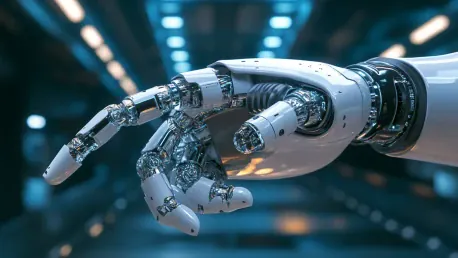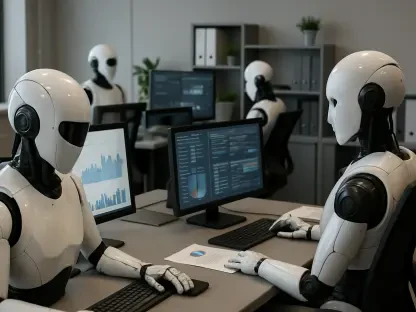As we approach the mid-2020s, hyper automation stands on the brink of revolutionizing various industries by combining advanced technologies like artificial intelligence (AI), machine learning (ML), robotic process automation (RPA), and low-code platforms. This transformative trend promises unparalleled efficiency, enhanced decision-making capabilities, and the liberation of personnel to focus on more valuable tasks rather than repetitive ones. With the potential to significantly influence future business growth, hyper automation is set to automate as many business and IT processes as possible, making it a major game-changer for organizations across the globe. From AI-powered process discovery to the convergence of RPA and AI, let’s delve into the emerging developments in hyper automation.
AI-Powered Process Discovery and Optimization
AI-powered process discovery and optimization tools play a crucial role in the landscape of hyper automation. Enhanced by the capabilities of AI and ML, these tools allow companies to map and optimize workflows with minimal human intervention. The integration of AI-powered process mining can seamlessly identify inefficiencies in existing workflows and recommend optimizations, taking decisions that would typically require considerable human effort. By 2025, these tools are expected to provide deeper insights by analyzing unstructured data and facilitating real-time monitoring, significantly reducing operational bottlenecks and improving overall productivity in the process.
Enhanced cognitive automation stands out as another key advancement in the realm of hyper automation. Cognitive automation encompasses AI applications that recognize patterns, comprehend language, or make decisions autonomously. In hyper-automated environments, cognitive technologies are increasingly embedded in workflows to undertake complex tasks that were once heavily dependent on human intervention. For instance, natural language processing (NLP) proves highly effective for customer service chatbots and intelligent document processing. By 2025, hyper automation solutions will extensively leverage cognitive AI, empowering systems to handle unstructured data and make sophisticated decisions with remarkable accuracy and efficiency.
Convergence of RPA and AI in Autonomous Operations
The convergence of RPA and AI in autonomous operations represents a significant leap forward for organizations. Traditionally, RPA has been employed for executing routine, rule-based processes. However, when integrated with AI, RPA evolves to become more adaptive and intelligent, capable of handling intricate tasks independently. By 2025, we can anticipate RPA systems augmented with AI that will learn, adapt, and improve their performance over time, facilitating intelligent decision-making. This newfound capability will enable organizations to establish autonomous workflows that adjust dynamically based on real-time data, thereby minimizing human intervention in routine daily operations and optimizing efficiency.
Another foundational aspect of hyper automation to consider is the widespread adoption of low-code and no-code platforms. These platforms make it feasible for non-technical users to create and implement automation workflows without requiring extensive coding knowledge. The democratization of automation enables broader employee participation in digital transformation initiatives, which was previously restricted to those with technical expertise. By 2025, it is likely that these tools will include more pre-built AI and ML capabilities, simplifying the development of scalable process automation and integration solutions. Enhanced and user-friendly interfaces will empower employees to design, adapt, and manage automated processes specifically tailored to their unique needs, fostering greater innovation and agility within organizations.
Intelligent Document Processing (IDP)
Intelligent document processing (IDP) is set to be integral for managing the burgeoning volume of unstructured data, such as PDFs, emails, and scanned documents. Combining AI, optical character recognition (OCR), and RPA technologies, IDP is adept at extracting, analyzing, and processing data from various document formats. By 2025, IDP is expected to become a pivotal component of hyper automation initiatives, particularly in document-intensive sectors like finance, healthcare, and legal services. This technology will streamline document processing, reduce the amount of manual labor involved, and enhance data accuracy, allowing businesses to operate more efficiently and make decisions based on reliable information.
The integration of the Internet of Things (IoT) with hyper automation is another critical trend to watch. IoT connectivity results in an ever-growing network of devices that generate vast quantities of real-time data. By harnessing IoT data, hyper automation will help organizations across industries streamline their operations and make better-informed decisions. For instance, IoT sensors can monitor the condition of manufacturing equipment, and hyper automation systems can autonomously schedule maintenance as needed. By 2025, the synergy between IoT and hyper automation is expected to flourish, further optimizing supply chains, enhancing asset management, and improving predictive maintenance strategies, ultimately transforming operational efficiency.
Hyper-Personalization
Hyper-personalization emerges as another significant outcome of hyper automation by 2025. Leveraging copious amounts of customer data, hyper automation will enable the delivery of personalized experiences at an unprecedented scale. Companies operating in sectors such as e-commerce, banking, and healthcare can track customer behavior, preferences, and interactions in real-time to offer bespoke services and product recommendations. For example, financial institutions will be able to provide tailored financial advice, while retail businesses can launch targeted promotions based on customers’ past purchase history. This hyper-personalization aims to enhance customer engagement and satisfaction by delivering relevant and timely offers that resonate with individual needs.
The concept of process simulation using digital twins is another anticipated advancement in hyper automation. Digital twins, which are virtual replicas of physical systems, are widely employed in the manufacturing sector. By 2025, these digital models are expected to be used more extensively across hyper automation to simulate business processes, evaluate innovative automation techniques, and forecast potential outcomes. Such digital twins will allow companies to experiment with and refine their automation strategies within a controlled virtual environment before implementation. For example, a business can simulate the automation of a supply chain process, ensuring that it achieves the desired results without disrupting daily operations, thereby mitigating risk and fostering continuous improvement.
Strategic Implementation Timeline
The convergence of RPA and AI in autonomous operations is a major leap for organizations. Traditionally, RPA was used for routine, rule-based tasks. However, integrating AI allows RPA to be more adaptive and intelligent, managing complex tasks independently. By 2025, we expect AI-enhanced RPA systems that will learn, adapt, and improve over time, enabling intelligent decision-making. This capability will help organizations establish autonomous workflows that adjust dynamically based on real-time data, reducing human intervention in daily operations and optimizing efficiency.
Another key aspect of hyper automation is the rise of low-code and no-code platforms, allowing non-technical users to create and implement automation workflows without extensive coding knowledge. This democratization of automation broadens employee participation in digital transformation initiatives that were once limited to those with technical skills. By 2025, these tools will likely incorporate more pre-built AI and ML capabilities, making it easier to develop scalable automation solutions. User-friendly interfaces will empower employees to design, adapt, and manage automated processes tailored to their needs, fostering innovation and agility within organizations.









